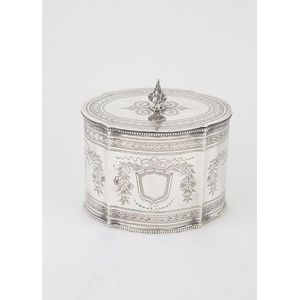Victorian Sterling Silver Tea Caddy with Engraved Decoration
You must be a subscriber, and be logged in to view price and dealer details.
Subscribe Now to view actual auction price for this item
When you subscribe, you have the option of setting the currency in which to display prices to $Au, $US, $NZ or Stg.
- Quatrefoil - A stylised four-circle design, itself contained within a larger circle, with Gothic origins and often seen as window designs in ecclesiastical architecture. The use of the motif was popular in Gothic Revival furniture of the 19th century.
- Bright Cut Decoration - Bright cut decoration is a technique used to decorate silver and other metal objects, such as jewellery and flatware, with intricate and detailed patterns. The technique involves using a small, sharp tool called a graver to carve designs into the surface of the metal. These designs are then polished, creating a bright, reflective surface that contrasts with the surrounding metal. The designs can be simple or complex, and can include geometric shapes, scrolling vines, and other decorative elements. The technique is highly skilled and requires a lot of precision, patience and attention to detail.
Bright cut decoration was widely used in the 18th and 19th centuries, particularly in the silverware and jewellery industries. It was popular in the United States, Great Britain and Europe.
Today, bright cut decoration is still used by some craftsmen and artists, but it is considered a traditional technique and is not as widely used as it was in the past. However, the bright cut decoration on a silver object is still considered a sign of quality and craftsmanship and is highly prized by collectors of antique silver and other metal objects. - Sterling Silver - Sterling silver is a mixture of 92.5% pure silver and 7.5% of another metal, usually copper. Fine silver is 99.9% pure silver, and is relatively soft and the addition of the very small amount of copper gives the metal enough strength and hardness to be worked into jewellery, decorative and household objects.
- Victorian Period - The Victorian period of furniture and decorative arts design covers the reign of Queen Victoria from 1837 to 1901. There was not one dominant style of furniture in the Victorian period. Designers used and modified many historical styles such as Gothic, Tudor, Elizabethan, English Rococo, Neoclassical and others, although use of some styles, such as English Rococo and Gothic tended to dominate the furniture manufacture of the period.
The Victorian period was preceded by the Regency and William IV periods, and followed by the Edwardian period, named for Edward VII (1841 ? 1910) who was King of the United Kingdom and the British Dominions and Emperor of India for the brief period from 1901 until his death in 1910. - Floral Swag / Garland / Festoon - Floral swags are a decorative motif often used in the ornamentation of various objects, such as silverware, glassware, and furniture. The term "swag" refers to a garland or wreath of flowers, foliage, or other decorative elements, which is usually arranged in a loop or curve.
Floral swags can be found in a variety of decorative styles, from ornate Baroque and Rococo designs to more naturalistic Art Nouveau and Art Deco styles. They are often used to add a touch of elegance, refinement, or whimsy to an object, and can be seen on a range of items from chandeliers and candlesticks to picture frames and tea sets.
In the decoration of silver objects, floral swags are often used to accentuate the curves and lines of the piece, and to add visual interest to the surface. Similarly, on glass objects, floral swags may be used to frame or highlight a particular area of the object, or to add a touch of color and delicacy.
On furniture, floral swags can be found on a variety of pieces, from cabinets and armoires to chairs and sofas. They are often used to enhance the lines and curves of the furniture, and can be used to create a sense of movement and flow in the design.
Overall, floral swags are a versatile decorative element that can be adapted to a range of styles and applications, and have been used in the decoration of various objects throughout history.
This item has been included into following indexes:
Visually similar items

A clear glass food cover, French, circa 1900. 11 cm high, 14 cm diameter

A diamond set dress ring. 18ct white gold, made as a low band style dress ring, channel set across top section with three connected rows of fine quality princess cut diamonds, thirty-nine stones totalling approximately 1.17ct, merging to a square edged pla

Hallmarked silver etched bracelet with Birmingham hallmark, maker MG&Co, 1907

A small Victorian embossed silver basin, London 1888, with a 1747 Georgian silver coin in base.
